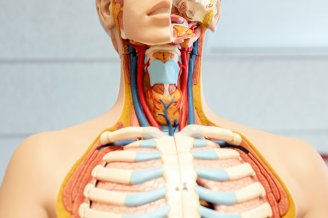
Thyroid Drugs
Abnormalities of the thyroid fall into two categories:
- Hypothyroidism—This refers to under-functioning of the thyroid.
- Hyperthyroidism—This refers to over-functioning of the thyroid.
Some other definitions
- Goiter: This is the swelling of thyroid tissue and can occur because of hypothyroidism.
- Thyrotoxicity: This is symptomatic hyperthyroidism with hyperactive metabolism.
- Thyroxine is the thyroid hormone T4 and is made in the thyroid.
- Tri-iodothyronine is the thyroid hormone T3 and is made in the thyroid.
- Thyroid-stimulating hormone is also known as TSH and is made in the pituitary gland of the brain when stimulated by hypothalamic TRH.
- TRH is the thyrotropin-releasing hormone and is made in the hypothalamus of the brain.
A tale of two hormones
Tri-iodothyronine (T3) is the active hormone of the body that controls the rate of metabolism, growth, and body temperature. T3 is broken down from thyroxine (T4), another thyroid hormone.
T4 is made by the thyroid after stimulation from a pituitary hormone known as the thyroid stimulating hormone (TSH). Further up the cascade, there is something that stimulates the pituitary production of TSH from the hypothalamus gland.
The thyroid relies on dietary iodine to make its hormones. Seafood is especially rich in iodine, but other sources include iodized salt, cranberries, strawberries, cheese, potatoes, and navy beans.
The human body’s thermostat
The thyroid maintains a consistent metabolism rate via what is called the hypothalamus-pituitary-thyroid axis. For example, if T4 or T3 levels are elevated, TSH levels will go down because the thyroid doesn’t need the pituitary stimulation. If T4 and T3 levels are deficient, TSH levels will rise. All of this is tempered at the hypothalamus, which is responsible for stimulating the pituitary to make TSH.
Euthyroid is as euthyroid does
The two ends of the spectrum away from the normal euthyroid state are hypothyroidism and hyperthyroidism.
In hypothyroidism, the thyroid does not make enough of thyroxine (T4). A hypothyroid state can result in fatigue and lethargy, weight gain, decreased sweating, cold intolerance, constipation, dry skin, brittle nails, thinning or loss of hair, depression, menstrual problems and infertility, high cholesterol, water retention, and heart disease.
In hyperthyroidism, the thyroid makes too much thyroxine (T4), thereby accelerating the metabolism. A hyperthyroid state can result in weight loss, increased sweating, anxiety, insomnia, emotional instability, tremors, palpitations, heat intolerance, increased appetite, menstrual irregularities or absence, and erectile dysfunction. Thyroid storm, the most severe form of thyrotoxicosis, is a life-threatening emergency because of its association with exaggerated cardiac activity.
What drugs are used to treat hypothyroidism?
Since hypothyroidism involves a deficiency in T3 and T4, treatment is based on addressing the cause of it, such as a dietary deficiency in iodine, and then simply replacing what the gland cannot make.
Levothyroxine: Thyroxine, or T4, was first synthesized in 1927. Levothyroxine (Synthroid) is a commonly prescribed medicine with over 20 million prescriptions a year in the USA alone. It is given orally, but it can also be injected in a shot or even via IV. It is taken once a day, usually in the evening on an empty stomach.
There is a generic form available, but it was accompanied by considerable controversy over the bioequivalence between the brand form and the generic form. The FDA, after its 1997 study, declared they were equivalent, but since some feel the study was flawed, it has become customary to monitor T4 and TSH levels when switching from one to the other.
Treatment success can be seen with TSH returning to normal levels and a reduction in any goiter and hypothyroid symptoms.
Treatment of hyperthyroidism
Hyperthyroidism and its elevated levels thyroid hormones prompt the pituitary gland to rectify the situation by decreasing its amount of thyroid stimulating hormone. Because T3 and T4 are the thyroid hormones, both or either can be elevated in hyperthyroidism. Treatment is based on not only treating the cause (tumor, pregnancy-related, and autoimmune, etc.) but also by doing the following:
- Correcting the symptoms: Beta-blockers are used to eliminate the uncomfortable symptoms of fast pulse, palpitations, anxiety, tremors, etc. Such substances include the following:
- Using antithyroid drugs: These, specifically thioamides, inhibit the synthesis of both T3 and T4. Such drugs include the following
- Carbimazole—This breaks down into methimazole (see below).
- PTU (propylthiouracil)—This is used to treat hyperthyroidism in pregnant individuals.
- Destroying thyroid tissue via radiation or surgery: Radioactive iodine is absorbed almost exclusively in the thyroid, making it an ideal treatment for destroying thyroid tissue. Pretreatment with something faster-acting, like methimazole (Tapazole), can help patients avoid the temporary worsening of the hyperthyroidism sometimes seen with iodine. It can also be used to shrink hypothyroid goiters.
How are drugs for thyroid treatment monitored?
The goal is a euthyroid state, which is where the thyroid is functioning normally and levels of the thyroid hormones and TSH are normal. The first hormone to respond to thyroid treatment drugs is the thyroid’s thyroxine (T4) hormone, then the thyroid’s tri-iodothyronine (T3) hormone, and then TSH.
How long is treatment?
Some thyroid conditions are permanent and require life-long therapy. Today’s formulations make this easy. Others may be temporary, although treatment can last years, as is the case with autoimmune thyroid conditions like Hashimoto’s thyroiditis and Graves’ disease. Some conditions, such as nodules, are cured via surgical removal. Some nodules are simply observed or shrink with medication.
Thyroid medication can be used to treat an under-functioning or over-functioning thyroid. The uniqueness of the thyroid gland requires a unique pharmaceutical approach for its treatment.
